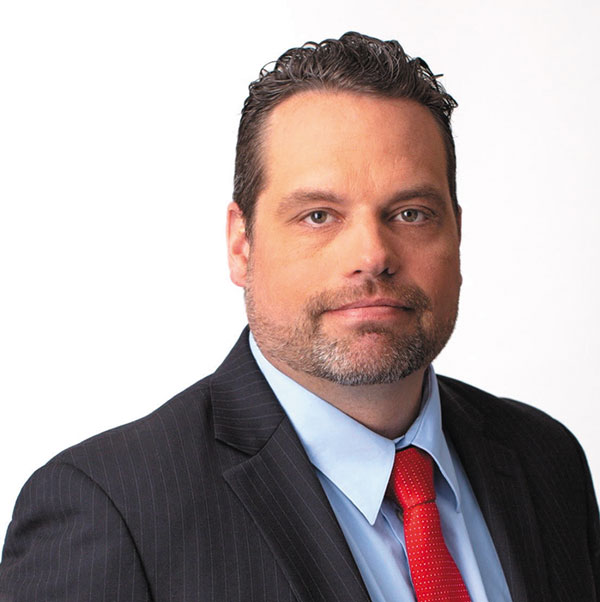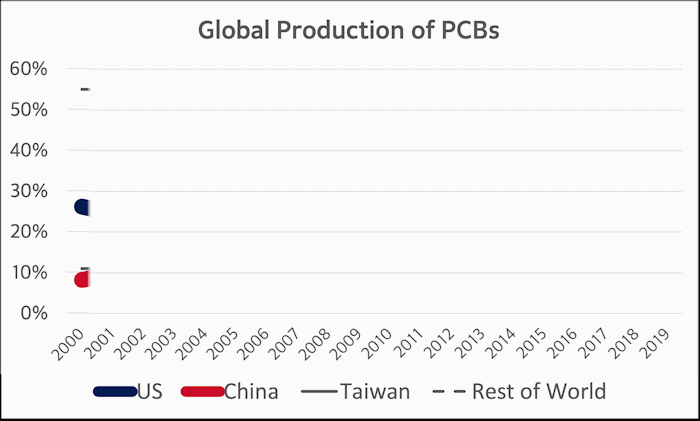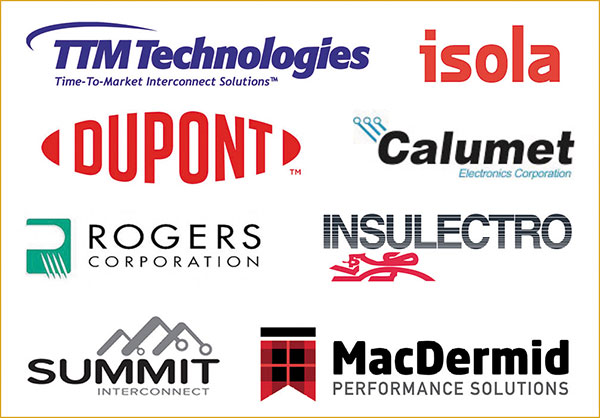Building a Resilient US Supply Chain
“Chips don’t float,” the saying goes, but it’s up to the PCB industry to push its message to Washington.
It’s hard to believe now, but veterans of the printed circuit board industry will remember when the US was neck and neck with Japan as the largest PCB manufacturing market. It peaked in 2000-2001 with sales north of $10 billion each year and close to a 30% share of the overall market.
How things change.
Today, US domestic PCB manufacturing output is around $3 billion, and its share of the global market is in the mid-single digits. Meanwhile, China has surged ahead of the pack, as more than half the bare boards produced each year are built on the mainland. Moreover, nations like Vietnam that didn’t even register a decade ago are now larger than the US market.
Last July, in response to two decades of a falling tide, a group of printed circuit board fabricators and suppliers established the Printed Circuit Board Association of America (PCBAA). This new consortium of US-based companies supports initiatives to advance US domestic production of PCBs and base materials.
The organization seeks market fairness and a level playing field on which US PCB manufacturers can compete against competitors subsidized by foreign governments.
Travis Kelly, president and chief executive of Isola, the materials developer, and chairman of the PCBAA, spoke with Mike Buetow for the PCB Chat (pcbchat.com) podcast in late December. The following transcript is lightly edited from that interview.
Mike Buetow: On its website, PCBAA asserts three main mission objectives. Let’s talk about them and how you settled on those three as focal points.

Travis Kelly, PCBAA Chairman
Travis Kelly: Just taking a quick step back, the PCBAA was formed by five prominent companies in the PCB industry that identified a need to educate, advocate, and legislate to support the competitiveness of the domestic PCB industry. That’s [how] we really got to the three pillars of what we stand for. First and foremost, it’s making people conversant – not only the general public but also the government – relative to microelectronics as it relates to the PCB industry. How do we educate and make people conversant on the topic? How do we advocate for the domestic industry, looking not only at semiconductors, which is an obviously big topic, but as we all know, chips don’t float. Chips have to be embedded in something. That’s why printed circuit boards are so important. So, advocating for printed circuit boards as part of the overall microelectronic ecosystem. And then, how do we advocate for legislation to get more recognition around the importance of PCBs and PCBAs?
MB: I spent quite a few years going to Washington as part of the IPC Capitol Hill Days, where we lobbied Congress to support the PCB industry. This effort began in the 1990s, well before the crash. But even as the domestic market migrated offshore, Congress’s response was effectively none at all. Fast forward to today. The past couple administrations seem much more intent on shoring up the domestic electronics manufacturing market. Much of the attention, however, is going toward semiconductors. I don’t intend to diminish these obviously critical components, but how do you propose to ensure PCBs are in the conversation?
TK: That’s a great point, Mike, and ultimately they have to be. There’s a systemic issue. Covid-19 was the catalyst for some of the global supply chain issues that we’re facing as a nation. It’s getting more recognition in terms of getting a resilient supply chain. Semiconductors are extremely important, but so are PCBs. We have to look at the overall ecosystem and not just one or two specific examples. What we’re trying to do now is bring the education around printed circuit boards as it relates to microelectronics. You brought up a strong point: The US once produced over 26% of the world’s PCBs. That number is down to 4%. Our goal right now is sustained government investment in the domestic PCB industry. I think with a lot of the tailwinds we are having, because there is a lot of focus on the global supply chain as it relates not only to semiconductors but microelectronics, consumables and a lot of other areas and a lot of other industries that are being impacted, it’s been helping us spread our message to help people be conversant on the importance of the ecosystem as it relates to microelectronics.
MB: Four or five years ago, the Department of Commerce undertook a study to assess the state of the domestic PCB industry. My understanding is one reason they did so was to help present data to the Defense Department to convince them to pay more attention to the interconnect industry. I’m not sure what really came out of that study, except for a lot of data and paper. Is the sense you get that the interest by Washington is focused mostly on defense suppliers, or do you think this effort will lead to a more widespread, robust PCB market if done correctly?
TK: The PCBAA has been at the table for the full legislative cycle this year to be sure our industry’s concerns are being communicated and addressed. We’ve advocated successfully for language in the Department of Defense legislation, the National Defense Authorization Act, requiring more domestic sources of materials and manufacturing. That addresses your first point: Is it really focused on defense? The answer in terms of the NDAA is absolutely. But as you start peeling back the onion and people start focusing on what we consider critical applications, it’s a broader reach. If you think about medical, infrastructure, 5G, critical applications as they relate to aerospace and defense opportunities, it’s going to be a broader scope. That’s something we all need to focus on because, just living through the last nine months of the global supply chain issues, it’s bigger than just defense products that are impacted. It’s a lot of different products, even if you go back to when Covid first happened, and there was a significant need in the US for ventilators, and automotive OEMs started producing ventilators as opposed to vehicles. A lot of us took part in terms of printed circuit board manufacturing for those ventilators, and the laminate and the materials that go in printed circuit boards. It’s a broader reach than just defense.

The US’s share of global PCB production has plummeted in the past 20 years.
MB: The number of PCB factories in the US has dropped from 780 in 2000 to fewer than 200 today. Moreover, the size of the factories – the amount of capacity – is considerably less as well. By comparison, China has almost 1,500 factories. Has PCBAA set any goals as to what a healthy US industry looks like, size-wise?
TK: I think you have to bifurcate the discussion. A lot of people focus on brick and mortar and how many companies is the right number of companies. I really think you have to get more into the specifics of what technology is needed to ensure we have a resilient supply chain within the United States. It’s less about the number of brick-and-mortar companies and more around are we fast enough as an ecosystem where we can produce the material, the technology that is needed to sustain the nation? That’s where the focus has to be. When you get into a discussion relative to 26% going down to 4%, or in Europe, for example, 800 [fabricators] going down to 200, that is significant, and that’s a lot of manufacturing that has been lost in this country. But furthermore, when you pursue offshoring, especially to the extent we have as a country, you also offshore knowledge. What we’re advocating for is how do we work with universities, with institutions, to bring that knowhow back? We see significant weakness there, and we need the government support to really focus on STEM, to partner with universities and bring back some of that technical knowhow that we’ve lost over the past several decades.
MB: Do you think we need a JFK moment right now? By that I mean, in 1960, John F. Kennedy announced the mission for the moon. There was the goal to put a human on the moon, but the bigger goal was to excite people about technology. Do we need something like that again to get people excited about what a career in electronics manufacturing could look like?
TK: I think we do. I think if you were to poll a lot of young professionals just entering their last year of post-secondary education or coming out into the workforce, most of those professionals or young students would not perceive this industry as something they would envision going into. You hear a lot about the larger software companies or data companies. You don’t really hear a lot of passion around the electronics manufacturing sector. I think we do need to really understand how we get in front of a lot of these talented students and talented young professionals to create that momentum. I think the onus is not only on the government, but also once again private industry to really build up on that momentum. What we do as a microelectronics industry, and primarily around PCBs and the material that goes into it, is exciting. We’re constantly innovating. There’s more to it than just what people say is a “green board.” There are a lot of complexities, a lot of challenges. It’s actually a very rewarding industry. We have to do a good job communicating and educating the public on what it takes to be successful in this industry, and I think that will create the momentum we need.
MB: Think back about 20 years ago. We used to think 5GB per second was the max we could get on a copper line through FR-4. Fast forward one generation and we are at 10 times that. These things are only known to the folks in the trenches, just how much development and progress there’s been over the past 20 years. All these devices we walk around with are unbelievably capable relative to a generation ago.
TK: Absolutely. It is fascinating. A lot of organizations within this industry are promoting that concept, that paradigm. We view IPC and USPAE as complementary organizations to what our goals are. As long as we continue to push this message to make people conversant and the government conversant on the fact that it’s a much larger ecosystem than just semiconductors, I think we can all be very successful. Success is having people understand the importance of the overall ecosystem of microelectronics, and how in fixing one problem – although it’s significant with semiconductors – you still have other significant issues that are going to hamper the success of the US if we don’t focus on a broader set of microelectronics including PCBs.
MB: In 2004, a group of primarily Chicago-area PCB fabricators formed the US Printed Circuit Association. That group, which was primarily formed to perform state and federal lobbying, garnered about 70 corporate members, but survived only a couple years. What’s different this time?
TK: I can’t speak too much to what happened with that organization, but ultimately there’s a lot of heavy lifting that has to be done for the domestic microelectronics industry. When we think about the recent successes, we’ve had such a short period of time. We have 10-plus members now with PCBAA, [which] doesn’t sound like a large group when you actually count them as wholly owned facilities or companies. However, when you think about the number of employees we represent, it is significant. I think with the quick wins we’ve had, and significant wins we’ve had in such a short period of time since this organization came to fruition, we’ll continue to have more momentum [and] broaden our membership base. It’s not as simple as, “Let’s get some language into a legislative bill that can help the overall industry.” We’ve talked about what has to happen in the educational system, what has to happen at the government level, what has to happen at the private level, even what has to happen with the infrastructure of this overall industry as it relates to PCBs. This is a heavy lift for many years to come. As we continue to develop our organization and grow our membership base, there’s always going to be activity. Activity can be defined as advocating for legislation; it can be defined as educating; it can be defined as creating different educational workstreams that help the overall industry. I don’t see this as a short-term organization. This is going to go well into the future because there’s always topics that have to be addressed, and not just from a high level. It’s looking at the systemic issues and trying to correct those, so we actually do have a resilient supply chain, as opposed to focusing on one or two items. Semiconductors [are] the main topic, but until we start addressing the real root cause of some of these issues, it’s never going to correct itself because, once again, chips don’t float. They have to be embedded on something. People have to take a broader look and understand the macros before they can start identifying root cause identification and solutions.

Some of the first members of the PCBAA.
MB: You’ve enlisted some of the biggest names in the US PCB industry as members: Isola, TTM Technologies, and Summit Interconnect are among the founding members. What is the cost relative to membership in, say, IPC?
TK: So, not to leave anyone out, we [also] have Calumet Electronics, Insulectro, DuPont, Rogers, MacDermid, and the list goes on and on. We’re going to continue to grow that momentum. In terms of the structure of the membership, we do not want to exclude companies that want to take an advocate role in this organization. We’ve set up different tiers. Depending on the size of the company – Is it an individual? Is it a company? Is it an educational institution? – we have different tranches of membership levels. If you’re [with] a large company and potentially want to have a board seat, that will be the gold level, and it will be based on a certain quantitative measurement. You’ll be able to sit on the board and have a voice at the table. If you want to fly the flag and show you’re a member of the PCBAA but want to do so at a lower level, we have different tiers set up. We’re trying to cover the gambit as it relates to membership, and it’s more just having momentum and good companies that want to be part of something bigger than just their sole company.
MB: What does it take to convince smaller fabricators, particularly ones who have felt left behind by Congress, that the investment now will make a difference for them?
TK: I think what we’ve been able to prove with our early successes as a young organization is creating a level of comfort for potential members, and because we continue to get our message out of what has been accomplished and what we see that needs to be accomplished in the future, regardless of size, a lot of different fabricators and assemblers will want take part in it. They had the opportunity to look at the different membership levels and say, “This may make sense for me. I’m part of something bigger than just my organization.” Then you may have some other fabricators that want to have a real voice at the table and help set the direction of the PCBAA, and a different tier may be right for them. Hopefully, the way we’ve thought about it is going to help generate more members as we continue to get this message out.
MB: We’ve talked a lot about fabricators. Where does the assembly industry fit into all of this?
TK: It’s not just PCB, not PCBA. It’s a large ecosystem, so we are being inclusive of everyone. That’s why, if you look at our membership base, it’s very interesting. We have suppliers of yarn that goes into materials. Isola is a material supplier. We have copper suppliers. We have chemical suppliers. So, we’re covering the gambit as it relates to different constituents within the PCB and PCBA industry, which is very helpful. It’s very inclusive, and it’s not just strictly PCB or PCBA. It’s people and companies that have direct input into the overall microelectronics industry.
MB: Finally, what does a unified, consensus strategy for the US industry look like, or is it too early to really describe that?
TK: I think that’s pretty abstract. It’s a global economy, so it’s not going to be 100% onshoring in the United States; we all recognize that doesn’t make sense. What we’re trying to do is ensure we have a resilient supply chain within the domestic industry, and [define] those critical applications that need to be addressed, and how can we ensure we’re shoring up the supply chain to make sure if there is another pandemic down the road, or even this current one with different variants, we don’t find ourselves scrambling to make ventilators for the population? That’s what we need to do, and that’s what success looks like. We live in a global economy, and that’s not going to change, but at the same time it’s not a mutually exclusive conversation. You can still work and participate in a global economy, as well as create a very robust supply chain domestically.
is president of PCEA (pcea.net); This email address is being protected from spambots. You need JavaScript enabled to view it..




